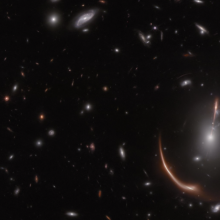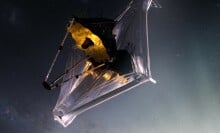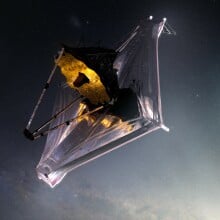Something traumatic must have happened to the Beta Pictoris star system within the 20th century.
That might not seem recent, but considering the universe is thought to be 13.8 billion years old, the notion that a major cosmic event happened within some living humans' lifespans — and can be studied — is fascinating to astronomers.
Beta Pictoris, a nearby star with at least two orbiting planets, is about 63 light-years from Earth in the southern constellation Pictor. It's visible to the naked eye in the southern sky. A team of scientists used the powerful James Webb Space Telescope, a collaboration of NASA and the European and Canadian space agencies, to make the discovery. The infrared space observatory again showed its prowess in finding details never before detected by other telescopes.
Webb revealed a new dusty feature at Beta Pictoris, curled like a cat's tail. Now, the team is trying to figure out what caused it.
"While there have been previous observations from the ground in this (light) wavelength range, they did not have the sensitivity and the spatial resolution that we now have with Webb, so they didn’t detect this feature," said Isabel Rebollido of the Astrobiology Center in Spain, in a statement.
Tweet may have been deleted
Rebollido is the lead author of a new study on these findings, set to be published in the Astronomical Journal.
Previous telescope observations of Beta Pictoris have revealed the system has two disks of debris caused by collisions between asteroids, comets, and other small planet-like bodies. Planets are thought to form in such disks.
With computer modeling, the Webb researchers hypothesized that a cosmic event within the past 100 years must have produced the dusty curl.

"Something happens — like a collision — and a lot of dust is produced," said Marshall Perrin, a co-author of the study, in a statement. “At first, the dust goes in the same orbital direction as its source, but then it also starts to spread out."
The light from the star pushes the smallest, fluffiest dust particles away from the star faster, Perrin added, while the bigger grains don't move as much, creating a long trail of dust. This one extends from the southwest portion of the secondary debris disk.
Webb also revealed differences in temperature between the two disks, likely indicating that they're composed of different substances. In visible light, the material that makes the secondary disk and dust tail is dark. But with Webb's infrared vision, it glows.
Taking into consideration the tail’s brightness, the team has estimated the amount of dust in it to be on par with a large main belt asteroid dispersed across 10 billion miles.
A recent collision within the system's debris disks could also explain a feature previously spotted by the Atacama Large Millimeter Array in 2014. The telescope observed a clump of carbon monoxide near the cat’s tail. Because a star’s radiation should destroy carbon monoxide within about a century, this still-existing gas concentration could be evidence of the same event.
If so, the Beta Pictoris system may be even more chaotic than researchers thought.
Topics NASA





























